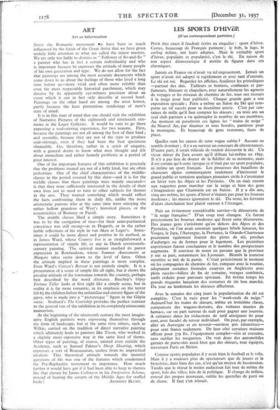ART
Art as Information
SINCE the Romantic movement *e have been so much influenced by the fetish of the Great Artist that we have given
unduly little attention to what are called the minor masters. We are only too liable to dismiss as "Follower of So-and-So " a painter who has in fact a certain individuality and who is important because he expresses the attitude of many people of his own generation and type. We do not allow for the fact that paintings are among the most accurate documents which come down to us about the feelings of those who lived a long time before us—more vivid and often more reliable than even the most respectable historical parchment, which may deceive by its apparently eye-witness precision about an event which it can in fact only describe at second hand. Paintings on the other hand are among the most honest, partly because the least pretentious renderings of men's state of mind.
It is in this state of mind that one should visit the exhibition of Narrative Pictures of the eighteenth and nineteenth cen- turies at the Leger Galleries. It would be vain to go there expecting a soul-stirring experience, for two reasons. First, because the paintings are not all among the best of their kind ; and secondly, because they are not of the type to produce soul-stirrings, even if they had been the best specimens obtainable. Go, therefore, rather in a spirit of enquiry, with a general desire to know what men thought and felt about immediate and rather homely problems at a period of great interest.
One of the important features of this exhibition is precisely that the problems treated are not of a lofty kind, but are often pedestrian. One of the chief characteristics of the middle- classes in the period covered by this show—and it is for the middle classes that these paintings were mainly executed— is that they were sufficiently interested in the details of their own lives not to need to turn to other subjects for themes in the arts. They wanted something which would reflect the facts confronting them in daily life, unlike the more aristocratic patrons who at the same time were enjoying the rather hollow grandeur of West's historical pieces, or the eccentricities of Romney or Fuseli.
The middle classes liked a simple story. Sometimes it was to be the castigation of vice—for their semi-puritanical conscience was still strong—as in Hogarth, or in the rather feeble reflections of his style in van Aken at Leger's. Some-. times it could be more direct and positive in its method, as in James Ward, whose Country Inn is as straightforward a representation of simple life as any in Dutch seventeenth- century painting. The satirical manner reached its purest expression in Rowlandson, whose Summer Amusements at Margate takes satire down to the level of farce. Often the attitude implied in these paintings is more complex. Even Ward's Citizen's Retreat is not entirely simple. It is a presentation of a scene of simple life all right, but it shows the peculiar attitude of the townsman towards the country, perhaps best described by the word dilettante. Beechey's Gipsy Fortune Teller looks at first sight like a simple scene, but in reality it is far more romantic, in its emphasis on the terror felt by the children before the unfamiliar and sinister figure of the gipsy, who is made into a " picturesque " figure in the Gilpin sense. Stothard's The Courtship provides the perfect contrast to the general run of the exhibition in its completely aristocratic mannerism.
At the beginning of the nineteenth century the most imagin- ative English painters were expressing themselves through the form of landscape, but at the same time others, such as Wilkie, carried on the tradition of direct narrative painting which ultimately leads to painters like Tissot, who worked in a slightly more expensive way at the same kind of theme. Other types of painting, of course, existed even outside the Academy, such as Samuel Palmer's Sheep Shearing, which expresses a sort of Rousseauism, useless from its unpractical idealism. This theoretical attitude towards the material questions of life was one of the features which condemned the Pre-Raphaelite movement to impotence. How much further it would have got if it had been able to keep to themes like that chosen by James Collinson in his Emigration Scheme, instead of beating the coverts of the Middle Ages for stuffed
































 Previous page
Previous page